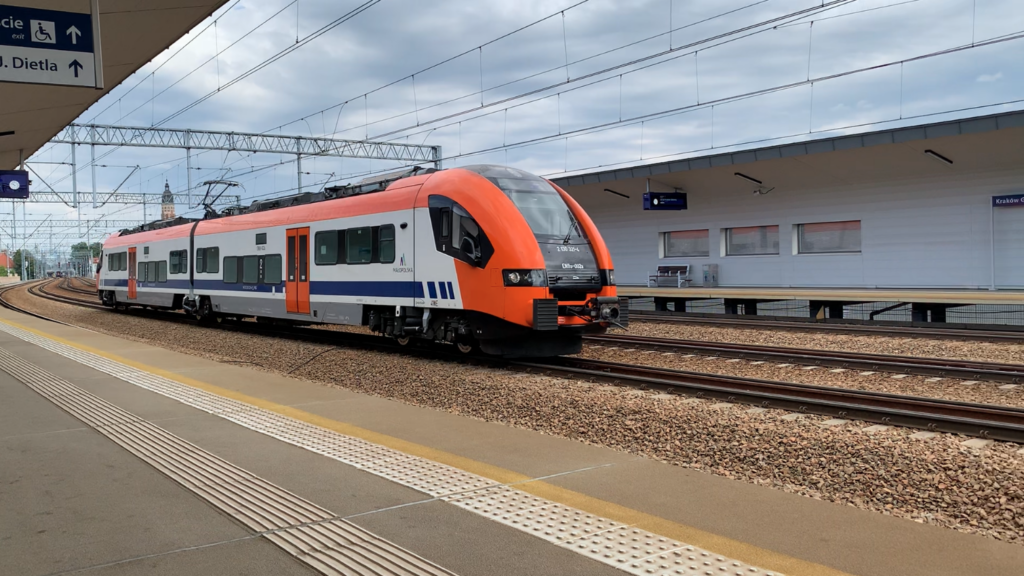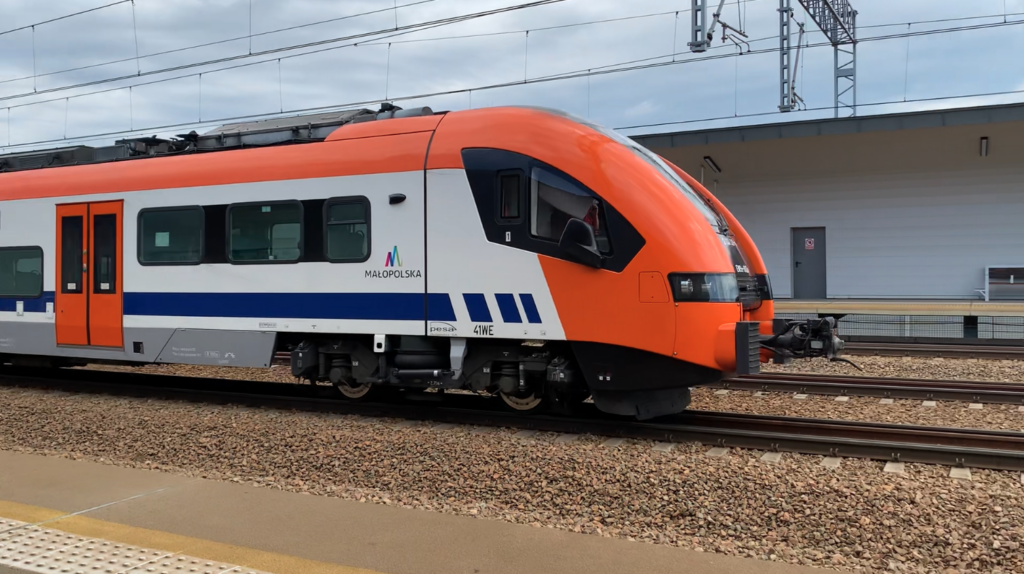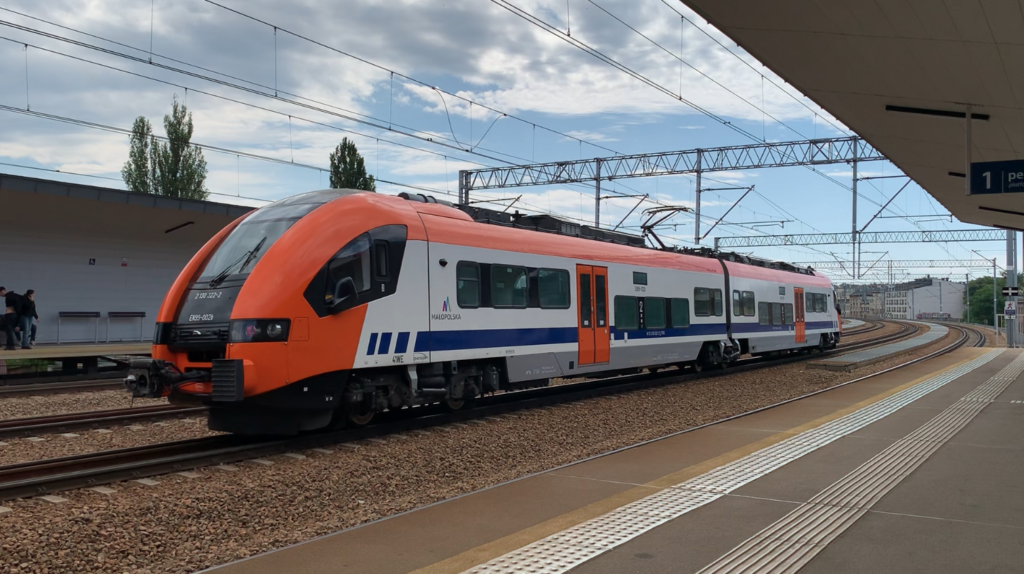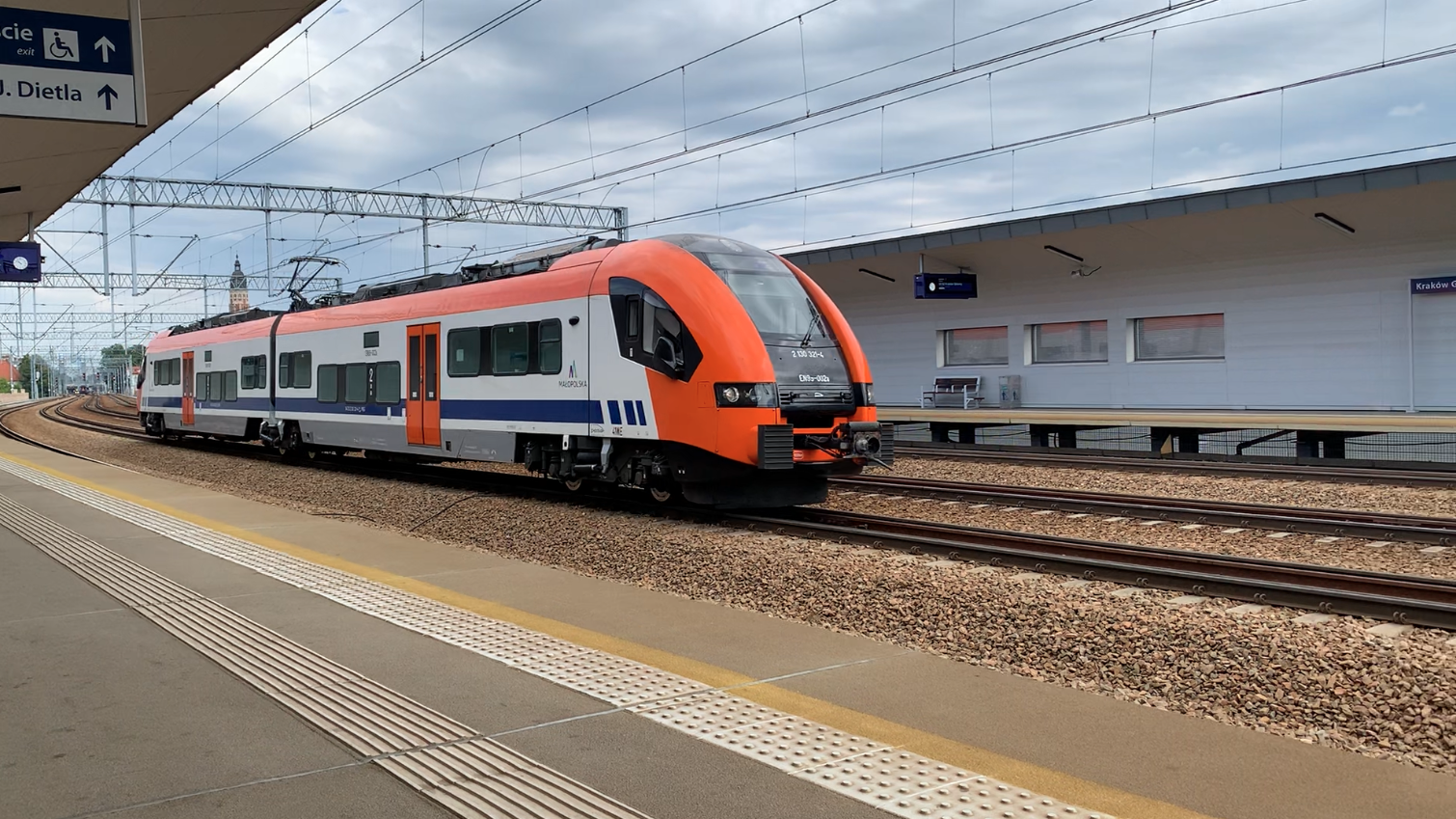Kraków 2025-07-14
EZT Pesa EN99-002 = 41WE Acatus.



Pesa Elf trains are Polish electric multiple units adapted for regional traffic. The trains have been built since 2010 at the Polish Pesa factory in Bydgoszcz. “Elf” is an acronym for electric low floor. Pesa Elf trains are manufactured with varying numbers of cars, from two to six. The equipment, seating layout, number of toilets, etc., also varies.
The Elf train family includes the following models: Type EN62 = 21WE, Type EN76 = 22WE, Type EN96 = 34WE, and Type 27WE for SKM Warszawa. In addition, ETZ trains designated Acatus II and Acatus Plus were built. Type EN77 = 32WE Acatus II – 4-carriage trains. Type EN64 = 40WE Acatus Plus – 3-carriage trains. Type EN99 = 41WE Actus Plus – 2-carriage trains. By 2020, over 120 Pesa Elf trains had been produced. The Elf II train is an Elf train adapted to the new regulations, i.e., the technical specifications for interoperability.
Pesa Elf trains are powered by 3 kV DC electric traction. The train is 2.88 m wide and 4.28 m high, with its length depending on the number of carriages. The design speed of Elf trains is 160 km/h.
The Pesa Acatus II is described as a low-power version of the ETZ Elf train, although passengers might not notice this. Despite its name, the train has little in common with the first Acatus Pesa train. The Acatus II was produced between 2010 and 2011, exclusively for the Lesser Poland Voivodeship. The Pesa Acatus II is designated type 32WE and carries the EN77 series. It is a four-carriage train.W dniu 28 stycznia 2010 roku, została podpisana umowa na dostawę 5 nowych pociągów ETZ typu Acatus II z samorządem województwa małopolskiego. Acatus II to były pierwsze EZT kupione przez województwo małopolskie. W dniu 28 stycznia 2011 roku, pierwsze 2 pociągi zostały dostarczone do Krakowa i ruszyły w pierwszy kurs w barwach Przewozów Regionalnych do Tarnowa i do Krynicy przez Tarnów i Nowy Sącz. Kolejne dwa składy zostały dostarczone w dniu 29 marca 2011 roku. Ostatni, piąty Acatus II, został dostarczony w maju 2011 roku. We wrześniu 2011 roku, pociągom nadano imiona własne: EN77-001 Pawie Pióro, EN77-002 Jaskółka, EN77-003 Jura, EN77-004 Nikifor, EN77-005 Tischner.
Initially, the trains were operated by Przewozy Regionalne, and from December 2015, by the newly established Koleje Małopolskie, which has owned the vehicles since 2018. In 2012 and 2013, problems arose with excessive wear of the wheel sets. This problem was resolved. The trains were systematically repainted in new livery. In 2021, the trains were scheduled for P4 level repairs.
Pesa 40WE, EN64 Acatus Plus.
The Acatus Plus train was manufactured between 2014 and 2016. These trains are operated by Koleje Małopolskie and PolRegio. The trains bear the type designation EN64. A total of 13 trains were produced: nine three-carriage vehicles and four two-carriage vehicles. On September 4, 2013, a contract was signed for the delivery of two 40WE type EMUs for the Municipal Office of the Podkarpackie Voivodeship. On October 18, 2013, a contract was signed for the delivery of six 40WEa ETZ Acatus Plus 3-carriage trains and four 41WE 2-carriage trains for the Małopolskie Voivodeship. On August 25, 2015, a contract was signed for one 40WE ETZ for the Świętokrzyskie Voivodeship. In July 2014, the first 40WE Actus Plus ETZ passed tests and received a certificate.
Małopolskie Railways began operations on December 14, 2014. In the Małopolskie Voivodeship, trains were transferred between Przewozy Regionalne (PolRegio) and Małopolskie Railways.
The main differences between the Acatus Plus and the Acatus II lie in the use of different driving and trailing bogies. The driving bogies are type 27MN with a 2.70 m wheelbase. The driving bogies have been adapted to accommodate VEM engines and Gmeinder gearboxes. The trailing bogies are type 42AN with a 2.60 m wheelbase. The trailing bogies have a modified method of supporting the boxes on the bogie frame, using only a single pair of pneumatic springs. The Acatus Plus also meets higher crash standards.
The Acatus Plus type 40WEa is a 3-carriage train with 157 + 13 seats. It weighs 109 tons and is 58.95 m long. The train has four motors with a power output of 360 kW each. Maximum speed is 160 km/h. The train features air conditioning, a closed toilet, bicycle and stroller/wheelchair storage, WiFi, 230V power outlets, and ticket machines.
EN77 = 32WE Actus II – 4-carriage. EN64 = 40WE Actus Plus – 3-carriage. EN99 = 41WE Actus Plus – 2-carriage. Ultimately, 18 Acatus trains, over 120 Elf trains, and 25 Elf 2 trains were built.
Pesa design EN99 = 41WE Actus Plus – 2-carriage.
Four two-carriage trains were built between 2014 and 2015. All trains were destined for the Małopolska region. The trains are standard-gauge ETZ trains, powered by 3 kV DC electric traction. The train is 2.88 m wide, 4.28 m high and 42.65 m long. The design speed of Elf trains is 160 km/h. The train’s operating weight is 84,600 kg.
The trains are low-floor and designed for regional service. Access to the train is provided by a single pair of doors for each carriage. The floor in the door area is 760 mm above the railhead. An additional step is also provided at low platforms to facilitate boarding and alighting. The automatic doors are of the sliding type. The train seats 92 and can accommodate a maximum of 190 passengers. The train is air-conditioned and has a closed toilet system, also accessible to disabled passengers. The trains are operated in 2nd Class. Bicycles, strollers, and wheelchairs can be transported on board. 230 V power outlets and wireless Wi-Fi are available. The train is air-conditioned, with the main components mounted on the roof of the carriages.
The carriage bodies have a three-dimensional structure made of steel with closed profiles. The skin is 1.5 mm thick and made of steel, while the front of the vehicle is made of plastic. The trains’ front ends have an aerodynamic design. The headlights do not protrude from the front outline.
The train is supported by three bogies. The outer bogies are driven. The middle bogie is a Jacobs-type, trailing bogie. Each driving bogie has two electric motors. Each bogie has double suspension. The first stage consists of steel springs. The second stage consists of pneumatic springs. Hydraulic shock absorbers are installed for additional vibration damping. The driving and trailing bogies are designed and manufactured by Pesa. TMF 50-29-4 asynchronous motors (4 x 340 kW) are used. The motors are Austrian-made. The electric motors are inverter-controlled. The current collectors are Stemmann. Each car has one current collector. The braking system is Knorr-Bremse. The trains can be coupled into multiple trains.
EN99-002.
The EN99-002 train consists of two cars: EVN: 94 51 2 130 321-4 (PL-PREG A), EVN: 94 51 2 130 322-2 (PL-PREG B). The train was built in Bydgoszcz in January 2015 for the Marshal’s Office of the Małopolska Voivodeship. On February 6, 2015, the train began regular services in Małopolska. The train was painted orange, white, and blue. In October 2020, the train underwent level P4/1 repairs in Bydgoszcz. As of 2025, the train is still painted orange, white, and blue. The train is often lent to other carriers, including in the Świętokrzyskie Voivodeship. The EN99-002 EZT is very often combined with other EZTs to accommodate a larger number of passengers.
Written by Karol Placha Hetman
